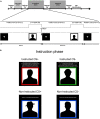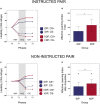Enhanced Instructed Fear Learning in Delusion-Proneness
- PMID: 35496229
- PMCID: PMC9043131
- DOI: 10.3389/fpsyg.2022.786778
Enhanced Instructed Fear Learning in Delusion-Proneness
Abstract
Psychosis is associated with distorted perceptions and deficient bottom-up learning such as classical fear conditioning. This has been interpreted as reflecting imprecise priors in low-level predictive coding systems. Paradoxically, overly strong beliefs, such as overvalued beliefs and delusions, are also present in psychosis-associated states. In line with this, research has suggested that patients with psychosis and associated phenotypes rely more on high-order priors to interpret perceptual input. In this behavioural and fMRI study we studied two types of fear learning, i.e., instructed fear learning mediated by verbal suggestions about fear contingencies and classical fear conditioning mediated by low level associative learning, in delusion proneness-a trait in healthy individuals linked to psychotic disorders. Subjects were shown four faces out of which two were coupled with an aversive stimulation (CS+) while two were not (CS-) in a fear conditioning procedure. Before the conditioning, subjects were informed about the contingencies for two of the faces of each type, while no information was given for the two other faces. We could thereby study the effect of both classical fear conditioning and instructed fear learning. Our main outcome variable was evaluative rating of the faces. Simultaneously, fMRI-measurements were performed to study underlying mechanisms. We postulated that instructed fear learning, measured with evaluative ratings, is stronger in psychosis-related phenotypes, in contrast to classical fear conditioning that has repeatedly been shown to be weaker in these groups. In line with our hypothesis, we observed significantly larger instructed fear learning on a behavioural level in delusion-prone individuals (n = 20) compared to non-delusion-prone subjects (n = 23; n = 20 in fMRI study). Instructed fear learning was associated with a bilateral activation of lateral orbitofrontal cortex that did not differ significantly between groups. However, delusion-prone subjects showed a stronger functional connectivity between right lateral orbitofrontal cortex and regions processing fear and pain. Our results suggest that psychosis-related states are associated with a strong instructed fear learning in addition to previously reported weak classical fear conditioning. Given the similarity between nocebo paradigms and instructed fear learning, our results also have an impact on understanding why nocebo effects differ between individuals.
Keywords: classical fear conditioning; delusion-proneness; expectations; fMRI; instructed fear learning; nocebo effect; orbitofrontal cortex; priors.
Copyright © 2022 Louzolo, Almeida, Guitart-Masip, Björnsdotter, Lebedev, Ingvar, Olsson and Petrovic.
Conflict of interest statement
The authors declare that the research was conducted in the absence of any commercial or financial relationships that could be construed as a potential conflict of interest.
Figures





Similar articles
-
Resolving the Delusion Paradox.Schizophr Bull. 2023 Nov 29;49(6):1425-1436. doi: 10.1093/schbul/sbad084. Schizophr Bull. 2023. PMID: 37478890 Free PMC article. Review.
-
Resistance to Extinction of Evaluative Fear Conditioning in Delusion Proneness.Schizophr Bull Open. 2022 Jun 5;3(1):sgac033. doi: 10.1093/schizbullopen/sgac033. eCollection 2022 Jan. Schizophr Bull Open. 2022. PMID: 39144763 Free PMC article.
-
Altered threat and safety neural processing linked to persecutory delusions in schizophrenia: a two-task fMRI study.Psychiatry Res. 2015 Sep 30;233(3):352-66. doi: 10.1016/j.pscychresns.2015.06.002. Epub 2015 Jun 23. Psychiatry Res. 2015. PMID: 26208746 Free PMC article.
-
Effects of Experiencing CS-US Pairings on Instructed Fear Reversal.J Neurosci. 2023 Jul 26;43(30):5546-5558. doi: 10.1523/JNEUROSCI.0665-22.2023. Epub 2023 Jul 6. J Neurosci. 2023. PMID: 37414559 Free PMC article.
-
Classical fear conditioning in functional neuroimaging.Curr Opin Neurobiol. 2000 Apr;10(2):219-23. doi: 10.1016/s0959-4388(00)00078-7. Curr Opin Neurobiol. 2000. PMID: 10753800 Review.
Cited by
-
Experimental Sleep Deprivation Results in Diminished Perceptual Stability Independently of Psychosis Proneness.Brain Sci. 2022 Oct 3;12(10):1338. doi: 10.3390/brainsci12101338. Brain Sci. 2022. PMID: 36291272 Free PMC article.
-
Resolving the Delusion Paradox.Schizophr Bull. 2023 Nov 29;49(6):1425-1436. doi: 10.1093/schbul/sbad084. Schizophr Bull. 2023. PMID: 37478890 Free PMC article. Review.
-
The Placebo Effect in Psychosis: Why It Matters and How to Measure It.Biol Psychiatry Glob Open Sci. 2023 Mar 5;3(4):605-613. doi: 10.1016/j.bpsgos.2023.02.008. eCollection 2023 Oct. Biol Psychiatry Glob Open Sci. 2023. PMID: 37881581 Free PMC article. Review.
-
Can the Predictive Processing Framework Explain the Persistence of Delusional Beliefs?Schizophr Bull. 2023 Nov 29;49(6):1411-1413. doi: 10.1093/schbul/sbad124. Schizophr Bull. 2023. PMID: 37931622 Free PMC article. No abstract available.
-
Resistance to Extinction of Evaluative Fear Conditioning in Delusion Proneness.Schizophr Bull Open. 2022 Jun 5;3(1):sgac033. doi: 10.1093/schizbullopen/sgac033. eCollection 2022 Jan. Schizophr Bull Open. 2022. PMID: 39144763 Free PMC article.
References
-
- Balog Z., Somlai Z., Kéri S. (2013). Aversive conditioning, schizotypy, and affective temperament in the framework of the salience hypothesis. Pers. Individ. Dif. 54 109–112.
LinkOut - more resources
Full Text Sources

